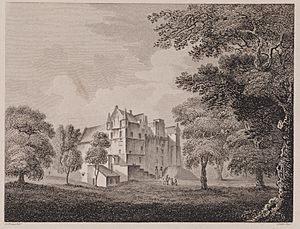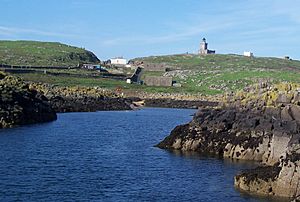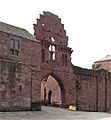More taubronar facts for kids
The More Taubronar (died 1507) was a talented musician of African origin who worked at the court of James IV of Scotland and his wife Margaret Tudor. His real name is not known. The word "taubron" meant a type of drum, similar to today's tabor. "More" or "Moryen" was a term used for people from Africa during that time. Records show that the More Taubronar created a special costumed dance, like a masque, for the Scottish royal court in 1505.

Contents
An African Drummer at Court
Even though his name is lost to history, we know some things about this drummer's life at the Scottish court. This information comes from the royal treasurer's accounts, which kept track of all the king's spending.
He first appeared in these records in December 1504. He was paid for three months of work. The "More taubronar" played at important places like Linlithgow Palace, Stirling Castle, and Falkland.
Traveling with the King
In September 1504, James IV traveled with this drummer and four Italian musicians. They went to places like Dumfries, Eskdale, and Peebles. The king also went north to Brechin, Darnaway, and Elgin in October 1504. The drummer and Italian musicians joined him on this trip.
During these travels, there were many dances. Maidens from Darnaway, Elgin, and Forres performed. The group also visited Huntly Castle on their way back. While the king was away, Margaret Tudor stayed at Dunfermline Palace with four young African women, known as the "More lasses".
Creating a Masque
In February 1505, the African drummer designed a special dance or masque for a tournament. It was held on Shrove-Tide, also called "Fasterins Eve." Twelve dancers wore black and white costumes, all created by "the More taubronaris devis" (the More taubronar's design).
Clothing and Payments
The "More taubronar" received special clothes. In December 1503, he got a coat made of camlet fabric with black and red threads. He also had a grey and purplish-brown damask doublet and striped hose.
In March 1505, he was given money to paint his drum. He also received a reward along with other court musicians. This payment was listed with money given to four Italian "schawmeris," who played the shawm, a type of woodwind instrument. These were likely the same Italian musicians mentioned earlier.
In December 1505, he received clothes made from Bruges satin, just like the four Italian musicians. Another drummer, Ansley, received a similar but slightly less expensive costume. In May 1506, the "More taubronar" was given a yellow coat lined with taffeta. This was for a special trip when the king sailed to the Isle of May, a place of pilgrimage in the Firth of Forth.

His Final Years
In June 1506, the "More taubronar" was injured at Holyrood. The king paid his doctor, called a "leech," for his care. In March and May 1507, James IV made payments to the drummer's wife and child. These payments suggest that the African drummer had passed away.
In February 1506, James IV gave money to a nurse who brought the "Moris barne" (the More's child) to him "to see." This might mean the king was curious about the child, possibly the drummer's.
Records about musicians at James IV's court were first published in the 1830s. Some people have wondered if "Peter the More," another person mentioned in the same records, was the same person. However, Peter is not listed as a musician.
Drummers, Dance, and Acrobats
Other records about drummers at court help us understand the role of the More Taubronar. Drummers, often called "taberers," usually played dance music.
Drummers and Dancers
In England, Catherine of Aragon also had a drummer. In January 1494, music for a masque at Westminster was played by a "small Tabret" (drum) and a "subtyle ffedyll" (fiddle). Henry VIII even owned a salt cellar that showed a Morris Dance with dancers and a "tabrett" player. In Scotland, a poem by William Dunbar describes dancing in Margaret Tudor's room.
One of the drummers at the Scottish court, Guilliam, taught the king's daughter Lady Margaret to dance. He also put on dances at Holyrood Palace in February 1507 to celebrate the birth of a prince, and again in February 1511. Guilliam even played for Margaret Tudor aboard the Great Michael or Margaret warship in 1512.

Other drummers at court included Pringill, who had his "tawberne" (drum) mended in 1489. At Easter 1501, drummers like Adam Boyd, Guilliam, Ansle, and John Portwis received cash rewards. These same drummers, plus the "taubronar of Leith," received New Year's Day gifts in January 1502. In January 1503, James IV was at Arbroath Abbey with two drummers and enjoyed entertainment from guisers (people in costumes). Ansle was a favorite and even played tennis with the king. The More Taubronar received a larger New Year's Day gift in January 1505 than the others.
Acrobats and Performers
On March 6, 1497, a "tawbronar" played at Stirling Castle with a "spelare." A "spelare" was an acrobat who performed physical theatre, including somersaults and tricks on a "cord" or tightrope. In March 1497, Ansle the drummer received an Easter reward. Two other drummers, Guilliame and Pais, received their reward with a "spelare." Pais also performed with a fiddler named Bennet.
Italian acrobats also entertained the court. In July 1502, James IV paid Peter de Luca, "the spelaris master." Peter and Francis de Luca, "the spelar boy," received regular payments. They might have been from Lucca in Italy. Francis performed at Stirling Castle, Perth, and Edinburgh. When Margaret Tudor arrived in Edinburgh, drummers played happily, and the "young Italian" acrobat performed on the tightrope the day after her wedding at Holyrood Palace.
Drummers and Sailors
On February 9, 1507, James IV visited a shipyard at Dumbarton. There, a drummer and a fiddler entertained him. Some drummers also served on the king's ships. The "taubronaris of the Jacat" received a reward for playing when the king sailed between Inchkeith and Kinghorn in May 1502. There was also a drummer on the Barge of Dundee.
Some wealthy nobles also had drummers. Robert Barton, a shipowner who provided wood for the king's ships, had a drummer on his ship in May 1504. The Barton family has been linked (though it's not certain) to the arrival of African people, including Ellen More, in Scotland.
Images for kids
-
Darnaway Castle where the "More taubronar" performed and the maidens of Forres danced
-
The More taubronar played for James IV on his May pilgrimage to the Isle of May
-
James IV spent New Year 1503 at Arbroath Abbey with entertainment provided by two taubronars




